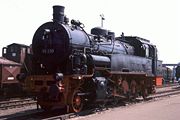
Union Giesserei Königsberg
Encyclopedia
Union Giesserei was a German engineering company based in Königsberg, East Prussia
.
 The families of Laubmeyer, Dultz and Schnell founded an iron foundry in Königsberg on 1 May 1828, that was given the name of Union Giesserei in 1845. On 1 April 1846 Johann Gottfried Dietrich Wilhelm Ostendorff (5 April 1812 - 23 September 1876) took over the running of Union Giesserei, and the manufacture of steam engines and boilers was started. On 5 December 1855, Union-Giesserei celebrated the delivery of its first steam locomotive, built for the Prussian Eastern Railway. On Ostendorff's death in 1876, Elias Radok (16 November 1840 - 30 March 1910), who had previously worked for A. Borsig in Berlin
The families of Laubmeyer, Dultz and Schnell founded an iron foundry in Königsberg on 1 May 1828, that was given the name of Union Giesserei in 1845. On 1 April 1846 Johann Gottfried Dietrich Wilhelm Ostendorff (5 April 1812 - 23 September 1876) took over the running of Union Giesserei, and the manufacture of steam engines and boilers was started. On 5 December 1855, Union-Giesserei celebrated the delivery of its first steam locomotive, built for the Prussian Eastern Railway. On Ostendorff's death in 1876, Elias Radok (16 November 1840 - 30 March 1910), who had previously worked for A. Borsig in Berlin
, took over the firm. It was changed from a public trading company to a public limited company on 2 June 1881. The board was now run by E. Radok and Ostendorff's son, Arthur, (18 May 1850 - 24 July 1891). When Elias Radok died, the factory was taken over by senior engineers, Georg Panck and Paul Fischer, together with the master builder, Max Hartung. Paul Fischer left in 1920 due to illness, Georg Panck died in 1923 and Max Hartung took over the helm until the arrival of Dr. Paul Brehm in November 1925.
Union Giesserei did not get any contracts from the newly-formed Deutsche Reichsbahn
and negotiations with the Reichsbahn proved largely fruitless. This led to severe economic problems in the company during the mid-1920s. In 1927, however, Union Giesserei was finally given orders for the construction of the DRG Class 64
and 80
steam locomotives as part of the 'eastern regions aid' (Ostlandhilfe) scheme. From 17 March 1930 it became a subsidiary of the F. Schichau GmbH
, which took over Union Giesserei completely in 1931.
East Prussia
East Prussia is the main part of the region of Prussia along the southeastern Baltic Coast from the 13th century to the end of World War II in May 1945. From 1772–1829 and 1878–1945, the Province of East Prussia was part of the German state of Prussia. The capital city was Königsberg.East Prussia...
.
History

Berlin
Berlin is the capital city of Germany and is one of the 16 states of Germany. With a population of 3.45 million people, Berlin is Germany's largest city. It is the second most populous city proper and the seventh most populous urban area in the European Union...
, took over the firm. It was changed from a public trading company to a public limited company on 2 June 1881. The board was now run by E. Radok and Ostendorff's son, Arthur, (18 May 1850 - 24 July 1891). When Elias Radok died, the factory was taken over by senior engineers, Georg Panck and Paul Fischer, together with the master builder, Max Hartung. Paul Fischer left in 1920 due to illness, Georg Panck died in 1923 and Max Hartung took over the helm until the arrival of Dr. Paul Brehm in November 1925.
Union Giesserei did not get any contracts from the newly-formed Deutsche Reichsbahn
Deutsche Reichsbahn-Gesellschaft
The Deutsche Reichsbahn – was the name of the German national railway created from the railways of the individual states of the German Empire following the end of World War I....
and negotiations with the Reichsbahn proved largely fruitless. This led to severe economic problems in the company during the mid-1920s. In 1927, however, Union Giesserei was finally given orders for the construction of the DRG Class 64
DRG Class 64
The Deutsche Reichsbahn had a standard passenger train tank engine with a wheel arrangement of 1'C1' or 2-6-2 and a low axle load, which was designated in their classification system as the DRG Class 64 . The Class 64 was developed from 1926 onwards and it was built between 1928 and 1940...
and 80
DRG Class 80
The Class 80 tank engines were German standard locomotives with the Deutsche Reichsbahn. They were intended to replace the aging, rickety state railway line engines performing shunting duties in their dotage at large stations.- History :...
steam locomotives as part of the 'eastern regions aid' (Ostlandhilfe) scheme. From 17 March 1930 it became a subsidiary of the F. Schichau GmbH
Schichau-Werke
The Schichau-Werke was a German engineering works and shipyard based in Elbing, formerly part of the German Empire, and which is today the town of Elbląg in northern Poland. It also had a subsidiary shipyard in Danzig .-Early years:...
, which took over Union Giesserei completely in 1931.
Sources
- Union-Giesserei: "100 Jahre Union-Giesser Königsberg Pr. 1828-1928", Festschrift zum 100jährigen Bestehen
External links
- There is a relevant English-language forum at Railways of Germany

